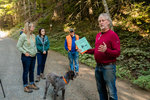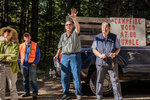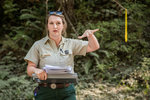














On Wednesday morning, an unlikely crew stood in a circle outside the Packwood Timberland Library.
One person wore a Cascade Forest Conservancy hoodie, representing a staunchly environmentalist, anti-mining and often anti-logging organization based out of Vancouver. Several sported U.S. Forest Service uniforms. Others were clad with hickory shirts and romeos, telltale signs of the logger.
These are the Pinchot Partners, and their interests are as diverse as their attire.
A nearly 20-year-old organization representing environmental, economic and educational interests in the Cowlitz Valley district of the Gifford Pinchot National Forest, they’re up against the age-old idea that loggers and environmentalists are mutually exclusive.
The group was founded in the wake of the Northern spotted owl controversy and today works closely with the Forest Service to make recommendations on behalf of the stakeholders involved. The partners include representatives from the Cowlitz and Yakima tribes, U.S. Forest Service, the Lewis County Outdoor Recreation and Tourism commission, businesses including Hampton Lumber, research institutions and many other agencies and organizations.
With two-and-a-half year executive director Janene Ritchie at the helm, the collective’s priority right now is a working document they’re calling the “Zones of Agreement” to guide future conversations by outlining shared values between the partners. Thus, the field trips. Getting into the forest is the best way to understand what’s worth agreeing on.
Along with other trips that have featured data collection and monitoring, this one was meant to show the partners what they mean when they talk about riparian zones, old growth stands, biodiversity and more.
Led by James Donahey, acting Cowlitz Valley District Ranger, the group caravanned into the forest from the library up Forest Service Road 47. The crew of around 17 would spend the day, from 9:30 a.m. to 4 p.m., visiting six stops and hearing from the experts including the rangers and Ken Wieman, a fish biologist.
The first stop was a look at riparian zones, or the boundaries around waterways such as creeks. The field trippers discuss succession: When was this logged? When has it burned? What did it look like before that? What will it look like in 80 years?
In the past, a study submitted to the Forest Service by the partners has formed the guide for how riparian zones are treated in the Gifford Pinchot.
With the interests of job creation, recreation and forest health as the main three tenants of the partners, the group is especially involved when the Forest Service takes on projects that require a National Environmental Policy Act (NEPA) assessment, during which, soliciting testimony from the public is required.
“It's essentially an extension of us interacting with the public. So, we don't have to take their recommendations, but we try our best to just work with them, just like we work with the public. In this instance, I think you can see they're more informed than most general public are,” Donahey said. “They've been involved in our planning processes. They have that history. They've all worked in different aspects of the outdoor industry.”
John Squires, former president of the partners, tags along and chimes in during the presentations. Gray-bearded and critical, Squires said his father worked for the Forest Service, “and as soon as he retired, he bitched about ‘em all the time.”
Despite his tenure with the organization and forestry in general, when Donahey and others talk about “basal area per acre,” essentially a measurement of forest density, he leans over and whispers, “I still don’t understand half this stuff.”
The field trips offer the chance to bridge the gap between the experts on these data points and the folks who gain from the forest, whether through profit or recreation. Most of the people who join in the process recognize the importance of both goals.
“The purpose of the field trip really is to educate us and our members on what's happening in the forest and even just about like a topic in general so that we can provide more and give more relevant feedback in future projects,” Ritchie said.
To learn more or get involved with the Pinchot Partners, https://www.pinchotpartners.org/.
The organization’s board meets from 9 to 11:30 a.m., on the third Wednesday of each month in Toledo and on Zoom.